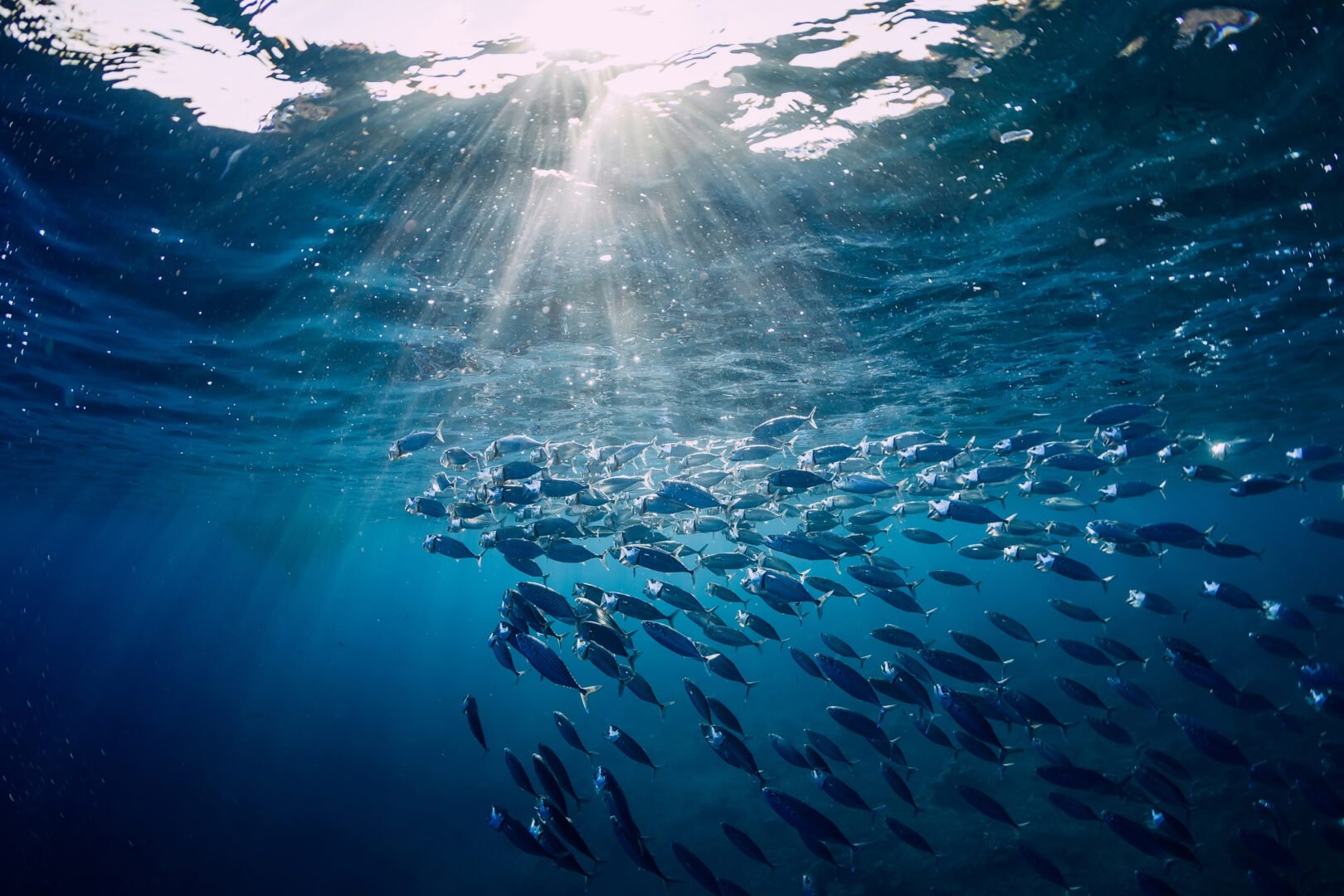With public and private sector support, cultivated seafood can restore the health of our oceans

Ensuring that alternative seafood reaches its full potential for restoring the health of our oceans requires collaboration across the alternative protein ecosystem, academia, governments, nonprofits, and others. Given the dire state of our planet’s oceans, any intervention requires an effective coordinated effort between all stakeholders. Cultivated seafood is no exception.
A recently published review paper, The long and narrow path for novel cell-based seafood to reduce fishing pressure for marine ecosystem recovery, details four core needs—taste, cost, sustainability, and collaboration—that must be met for cultivated seafood to reduce pressure on wild fish stocks and therefore contribute to ocean conservation efforts.
GFI—with partners from academia to industry—is working to ensure that alternative seafood maximally benefits the health of our oceans. With the right support, we believe that cultivated seafood can help sustainably meet the global demand for seafood and restore the health of our oceans.
Cultivated seafood needs to taste, smell, look, and feel like conventional seafood.
Cultivated seafood is unlike previous seafood alternatives such as plant-based seafood products. Cultivated seafood companies are not just creating a product designed to mimic the sensory and nutritional profiles of meat, but are instead creating genuine meat made of animal cells. While the novel nature of the technology will certainly entail an element of consumer education, it ultimately gives consumers who desire “the real thing” exactly what they are looking for.
Innovation in the field of cultivated meat and seafood is taking place at blazing speed. The world’s first cultivated hamburger prototype was revealed in 2013. Now, cultivated meat is well on its way to the mainstream market—the first cultivated chicken product was sold in Singapore at the end of 2020, and a multitude of cultivated meat companies are planning pilot-scale launches over the next few years.
Although the authors highlight technical hurdles to developing cultivated seafood, we believe that with government funding for open-access research and development, those hurdles can be overcome. In other words, the success of cultivated seafood is not inevitable; that is precisely why governments and NGOs that care about the oceans need to support open access R&D (both cultivated and plant-based), to transcend the hurdles identified by the authors.
Cultivated seafood needs to cost the same or less than conventional seafood.
We have seen significant progress on cost in the past eight years: In 2013, Mosa Meat’s cultivated hamburger cost over $300,000 to produce. Israel-based Future Meat Technologies announced in early 2021 that the cultivated meat company was producing cultivated chicken breasts for as low as $7.50 each. Talk about progress!
Cultivated seafood is a particularly promising sector for achieving price parity. Because small amounts of certain valuable conventional seafood products like bluefin tuna command a high price due to their sensory appeal and scarcity, cultivated versions of such products could actually out-compete their conventional counterparts on price quite early in the course of the industry’s development.
Aquaculture production costs have fallen steeply in recent decades due to investment and resulting innovation, and there is no reason why the same would not be true of cultivated seafood. But getting cultivated seafood costs down to the point of being competitive with the lowest cost conventional products will require significant investment from companies, governments, and philanthropic entities.
GFI is leveraging philanthropic giving to fund essential research to develop cultivated seafood and to accelerate progress toward price parity. Additionally, we are advocating for more government funding for foundational open-access research that can be leveraged by all companies and researchers. Governments across the world are investing in alternative protein research because the industry contributes to economic growth, food safety and security, global health, and environmental sustainability.
GFI is not alone in this call. Most recently, Breakthrough Energy released their federal policy plan, which calls for swift regulatory approval of cultivated meat, federal research and development funding for alternative protein, and fair, sensible food labels.
Cultivated seafood must outperform its conventional counterparts on sustainability.
Of course, central to the conservation benefits of alternative seafood is the assumption that cultivated fish and shellfish production perform better than conventional seafood on environmental metrics. Inherent inefficiencies in the conventional seafood production system point to the potential for cultivated seafood, when scaled, to have significantly lower environmental impacts. Instead of using resources to catch, transport, and process an entire fish, the alternative seafood industry only produces the portions of the fish that consumers actually want. Furthermore, cultivated seafood makes local production possible, even in landlocked areas, thereby cutting down on impacts related to transportation. Importantly, cultivated seafood entirely avoids the collateral environmental damage associated with harvesting sea life from sensitive ecosystems for direct human consumption or for aquaculture feed.
CE Delft recently conducted a Life Cycle Assessment (LCA) to understand the environmental impacts of cultivated meat and seafood. The results show that cultivated meat produced with renewable energy is associated with significantly lower greenhouse gas emissions, air and water pollution, water use, and land use compared to conventional terrestrial meat production. With relevant LCA studies on a number of wild capture seafood species, researchers will be able to rigorously compare the impacts of producing a serving of cultivated fish to a serving of wild-caught fish.
Cultivated seafood also has the potential to displace present and future aquaculture production. This is an essential consideration for sustainability assessments. If cultivated fish reduces demand for certain species of farmed fish, and producers in turn shift their attention towards engaging with the cultivated seafood industry, we could see a complex chain of impacts affecting wild capture fish—both because many aquaculture systems still rely on wild fish for feed and because the prices in both industries affect each other. Development of inexpensive and tasty cultivated salmon could very well serve to displace wild capture of poorly managed fish stocks such as anchovies and sardines, which are used as a source of fish meal and fish oil in aquaculture feed for carnivorous fish. By providing a viable alternative to both wild caught and farmed fish, cultivated seafood serves as a systemic solution to all of the concerns surrounding seafood production.
We need strong collaborations across industry, governments, and nonprofits to fully realize the potential of alternative seafood.
Private sector action may not be enough for alternative protein to achieve everything it sets out to achieve. To ensure alternative seafood has the greatest positive environmental impact, the industry needs support from the public sector too. At each step, the authors posit that market forces alone may not ensure that those conservation benefits are reached. We agree. Governments and nonprofits have a huge role to play in supplementing market forces, from academic research funding to consumer education to altered fishing subsidies.
The authors describe several dynamics that may cause a delay in fishers’ response to a price change. Fishers in well-managed fisheries are typically already catching less than they would without tight catch limits or quotas, and it is unlikely that these actors respond to price changes. Further, fishing subsidies can offset price impacts on fishing behavior. All of these factors point to the need for strong and coordinated policy efforts to alter incentives in parallel with the expansion of alternative seafood.
Of course, cultivated seafood can be most successful in coordination with other ocean sustainability practices. Strengthening fisheries management globally, reducing illegal, unreported, and unregulated fishing, and establishing more marine protected areas are all worthy endeavors in ensuring ecosystem recovery—especially considering the fact that cultivated seafood is not yet ready to be sold at scale.
To build a global food system that is better for our planet, we need myriad solutions. Just as the conservation community must pursue as many solutions as possible at this critical moment for our oceans, the alternative protein industry must pursue as many technology platforms as possible for creating meat and seafood without the animal—plant-based, fermentation-derived, and hybrid seafood also play a key role alongside cultivated seafood.
GFI’s Sustainable Seafood Initiative will continue collaborating with governments, academia, and other nonprofits to support open-access research and other policies that will maximize the likelihood of success for alternative proteins over time. With the public and private sector working together to address technical bottlenecks, researchers can answer essential questions about scaling cultivated seafood and building a sustainable food system that supports our oceans.

